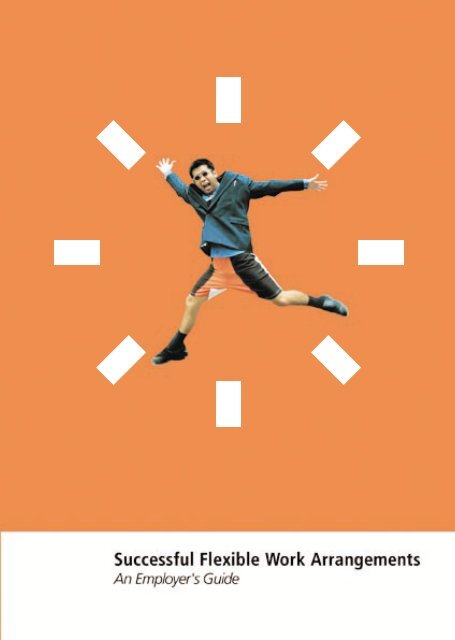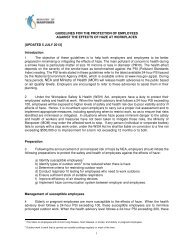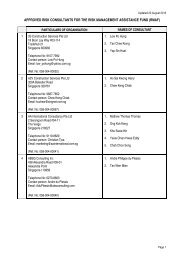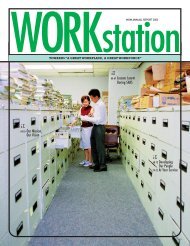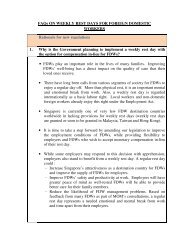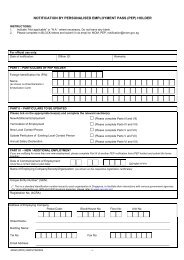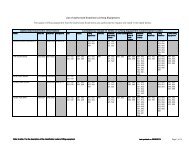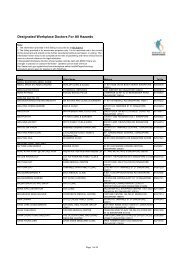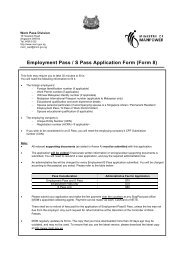Download - Ministry of Manpower
Download - Ministry of Manpower
Download - Ministry of Manpower
Create successful ePaper yourself
Turn your PDF publications into a flip-book with our unique Google optimized e-Paper software.
Let’s Get<br />
Flexible!
MCDS<br />
<strong>Ministry</strong> <strong>of</strong> Community<br />
Development and Sports<br />
SUCCESSFUL FLEXIBLE WORK ARRANGEMENTS:<br />
AN EMPLOYER’S GUIDE<br />
Published by the Work-Life Unit, Family Development Division<br />
<strong>Ministry</strong> <strong>of</strong> Community Development and Sports<br />
512 Thomson Road, MCDS Building, Singapore 298136<br />
Tel: 6355 8030 Fax: 6354 3976 Email: work-life@mcds.gov.sg<br />
Internet website: www.mcds.gov.sg<br />
Date <strong>of</strong> publication: Mar 2002<br />
ISBN 981-04-5880-0<br />
All rights reserved. No part <strong>of</strong> this publication may be reproduced<br />
for commercial use. Non-commercial users must acknowledge<br />
the <strong>Ministry</strong> <strong>of</strong> Community Development and Sports as source<br />
and keep the Work-Life Unit, Family Development Division <strong>of</strong> the<br />
<strong>Ministry</strong> informed prior to publication.<br />
Designed and printed by Kaleido Marketing Communications
pg 2 >>> Introduction<br />
pg 5 >>> CHAPTER 1 - Benefits <strong>of</strong><br />
Flexible Work Arrangements<br />
- Organizational Benefits<br />
- Benefits for Employees<br />
pg 11 >>> CHAPTER 2 - General Steps<br />
for Implementation<br />
pg 21 >>> CHAPTER 3 - Flexi-time<br />
- Definitions<br />
- Suitable Jobs For Flexi-Time<br />
- Suitability <strong>of</strong> Employee<br />
- Guidelines for HR Managers<br />
- Guidelines for Employees<br />
- Case Examples<br />
pg 29 >>> CHAPTER 4 - Flexi-place<br />
(Teleworking/Telecommuting)<br />
- Definition<br />
- Types <strong>of</strong> Telecommuting<br />
- What Jobs are Suitable For<br />
Telecommuting<br />
- Attributes <strong>of</strong> a Successful<br />
Telecommuter<br />
- Challenges to Telecommuting<br />
- Setting Up The Home Office<br />
- Guidelines for Managers<br />
- Guidelines for Employees<br />
- Case Examples<br />
pg 40 >>> Key Success Factors in<br />
Implementing a Flexible Work<br />
Arrangement<br />
Contents<br />
pg 41 >>> Conclusion<br />
APPENDICES<br />
pg 42 >>> Appendix A<br />
Steps to Cost-Benefit Analysis<br />
pg 43 >>> Appendix B<br />
Sample <strong>of</strong> a Company Guide to<br />
Flexible Work Arrangements<br />
pg 44 >>> Appendix C<br />
Sample Format for Flexible<br />
Work Arrangement Proposal<br />
pg 47 >>> Appendix D<br />
Checklist for Flexible Work<br />
Arrangement<br />
pg 48 >>> Appendix E<br />
Sample Telecommuting<br />
Agreement<br />
pg 50 >>> Appendix F<br />
Useful Websites on Flexible<br />
Work Arrangements<br />
pg 52 >>> Appendix G<br />
List <strong>of</strong> Useful Contacts<br />
pg 53 >>> Appendix H<br />
List <strong>of</strong> Available Work-Life<br />
Resources<br />
pg 54 >>> Appendix I<br />
Bibliography<br />
pg 55 >>> Appendix J<br />
Feedback Form
2<br />
Introduction<br />
* Flexibility and work-life support are fast<br />
becoming the key drivers <strong>of</strong> employee commitment.<br />
The new knowledge-based economy demands a<br />
transformation <strong>of</strong> workplace practices. Workplaces must be<br />
prepared to respond rapidly to changing needs <strong>of</strong> businesses and<br />
demands <strong>of</strong> a new generation <strong>of</strong> knowledge workers. In<br />
developed countries, flexible work arrangements are leading<br />
to fundamental changes in the workplace, challenging the<br />
way we think about where, when and how work is done.<br />
Singapore has to realign its workplace practices to<br />
catch up with the competition.<br />
Flexible work arrangements are fast becoming a<br />
competitive necessity. It is one <strong>of</strong> the key<br />
programmes <strong>of</strong> a growing class <strong>of</strong> work-life<br />
strategies. Whereas flexi-work has become an<br />
established work pattern in some developed<br />
countries, Singapore employers have been slow to<br />
catch on with only 0.3% <strong>of</strong> our workers adopting<br />
flexi-place as a flexible work arrangement compared<br />
to 3.3% in US and 4.1% in UK. Part-time workers<br />
make up only 4.7% as compared to 24% in the UK,
23% in Japan and 17% in the US. Less than<br />
1.5% are on flexi-time compared to 28% in<br />
the US, 12% in UK and 8.7% in Japan. 1<br />
Employers and employees alike have reasons<br />
for using flexible working patterns which<br />
work to each other’s advantage.<br />
Organizations may decide to implement<br />
flexible work arrangements either because they<br />
see these as a means to help solve an existing<br />
problem such as high absenteeism, or simply<br />
because they recognize the strategic importance <strong>of</strong><br />
helping staff balance their work and personal life.<br />
Work flexibility is also used as a key talent attraction<br />
tool. Companies that embark on flexi-work practices will<br />
achieve a win-win outcome for themselves and their employees. In<br />
the near future, flexi-work practices will be viewed as an integral<br />
part <strong>of</strong> workplaces.<br />
This booklet is aimed at helping human resource pr<strong>of</strong>essionals<br />
understand the varied forms <strong>of</strong> flexi-work and provide a succinct<br />
guide to implementing and evaluating the use <strong>of</strong> flexi-work in their<br />
companies. It is hoped that this guide will help companies to<br />
approach flexi-work as a means <strong>of</strong> gaining competitive advantage<br />
and to help their employees be effective in their work and personal<br />
lives. Now is the time for Singapore to align its workplace practices<br />
and culture to the new demands for flexibility.<br />
1 Report on Flexible Work Arrangements, <strong>Manpower</strong> Research and Statistics Dept<br />
<strong>of</strong> the <strong>Ministry</strong> <strong>of</strong> <strong>Manpower</strong>, Singapore.1999<br />
3
Chapter 1<br />
Benefits <strong>of</strong> Flexible<br />
Work Arrangements<br />
Both employers and employees benefit immensely<br />
from adopting flexible work arrangements. Overseas and local<br />
research has consistently found that they improve business results<br />
and the bottom-line whilst helping employees to enhance their work<br />
performance and quality <strong>of</strong> life.<br />
O R G A N I Z A T I O N A L B E N E F I T S<br />
*Customer Service<br />
In response to the 24-7 economy, flexiwork<br />
arrangements help provide<br />
round-the-clock customer service for<br />
banking and financial services,<br />
computer support, news, entertainment<br />
programmes, and late-night shopping.<br />
By providing longer hours <strong>of</strong> service,<br />
flexi-work therefore meets diverse<br />
customer needs and improves customer<br />
service and customer retention.<br />
Retention & Recruitment<br />
Retention <strong>of</strong> employees is a major<br />
reason behind workplace flexibility.<br />
Studies have shown that the workforce<br />
is increasingly placing a premium on<br />
achieving good work-life balance.<br />
Employees want the flexibility to<br />
manage their schedules to fulfill both<br />
work and personal responsibilities.<br />
The competition for talent is no<br />
longer confined to our local shores.<br />
The demand for multi-national talent<br />
(MNT) is global and their short supply<br />
enables them to look for jobs that<br />
allow them to enjoy a good quality<br />
<strong>of</strong> life. In this regard, flexi-work is a<br />
prerequisite for attracting and<br />
retaining skilled staff. Employers<br />
who provide it will have a competitive<br />
edge in the search for talent.<br />
Tapping a Wider<br />
<strong>Manpower</strong> Pool<br />
Singapore’s workforce is small and<br />
our declining birth rates and aging<br />
population aggravate this. In 1999,<br />
7% <strong>of</strong> Singapore’s population was 65<br />
years and above. By 2030, this age<br />
group would rise to 19%. 2 We also<br />
have a large proportion <strong>of</strong> untapped<br />
2 Report <strong>of</strong> the Inter-Ministerial Committee on the Ageing Population, Nov 1999, <strong>Ministry</strong> <strong>of</strong> Community<br />
Development and Sports.<br />
5
6<br />
female labour. 3 Employers who<br />
provide flexi-work will be able to tap<br />
the experience and expertise <strong>of</strong> senior<br />
citizens and female labour force who<br />
may not be able to take traditional<br />
working hours. It is also useful where<br />
work (such as project work) requires<br />
less than a full-time position.<br />
Productivity<br />
Employers have found flexi-work<br />
effective in reducing absenteeism as<br />
it provides more time for employees<br />
to handle personal demands without<br />
missing a whole day’s work. Research<br />
shows that telecommuters are 20%<br />
more productive on average when<br />
they work <strong>of</strong>fsite as they can focus<br />
on their work without interruption.<br />
In the event <strong>of</strong> major disruptions (eg.<br />
hand-foot mouth disease outbreaks),<br />
flexi-workers are also positioned to<br />
continue serving clients and completing<br />
assignments. Employers can<br />
therefore maintain productivity levels<br />
and circumvent losses linked to this.<br />
Morale<br />
Employees go the extra mile for<br />
employers who care for them and<br />
perceive them as whole persons<br />
rather than mere workers. Employers<br />
who respond to employee needs for<br />
flexibility will boost morale and<br />
cultivate loyalty to the firm.<br />
3 In 1999, the female labor force participation rate was only 52.7%. The main reason for women dropping<br />
out <strong>of</strong> the workforce was the difficulty <strong>of</strong> balancing work and domestic duties. Of those inactive persons who<br />
intend to seek work, half preferred to work part-time. Labor Force Survey, Jun 1998, <strong>Ministry</strong> <strong>of</strong> <strong>Manpower</strong>.
Cost Savings<br />
Flexible work practices enable companies to match work demands<br />
with the availability <strong>of</strong> employees. They are therefore able to<br />
provide longer operating hours without incurring overtime costs.<br />
Flexi-work options like telecommuting will reduce overheads such<br />
as rental costs, as well as the costs tied to employee absenteeism,<br />
lateness and sick leave. Employees can also schedule their<br />
workday outside normal business hours and hence reduce the<br />
costs <strong>of</strong> computer usage during peak hours.<br />
Retention <strong>of</strong> employees would also address the concern <strong>of</strong><br />
turnover thus resulting in substantial savings that would<br />
otherwise have been incurred in recruiting, training and<br />
developing new hires.<br />
Adjusting to Economic Situations<br />
Flexi-work helps companies to better match the peaks and<br />
troughs <strong>of</strong> their business activities without incurring significant<br />
increases in manpower costs.<br />
For instance, during difficult times, flexible work arrangements<br />
can give employers another method <strong>of</strong> adjusting cost by reducing<br />
the number <strong>of</strong> hours worked rather than terminating<br />
employment. Retrenchment is avoided or minimised because the<br />
flexibility <strong>of</strong> switching to job-sharing or part-time arrangements<br />
helps the organisation reduce costs yet retain the overall staff<br />
numbers. The original full-time arrangements can be reinstated<br />
when the economy improves.<br />
Environmentally Friendly<br />
With the environmental concerns <strong>of</strong> global warming, flexi-work is<br />
a strategy that encourages companies to help save the<br />
environment as not only is congestion reduced during peak hours,<br />
travelling time and pollution are also lowered.<br />
7
* Work-Life Balance<br />
Social and demographic changes have led to the rising trend <strong>of</strong> small, dual<br />
income families and the consequent need to juggle work and family<br />
responsibilities. Workforce expectations are moving towards greater work-life<br />
balance and quality <strong>of</strong> life. Organizations can use flexi-work to respond to<br />
employees’ desire for more wholesome lives.<br />
8<br />
B E N E F I T S F O R E M P L O Y E E S<br />
Health and Wellness<br />
Workplaces have a role to play in reducing the high levels <strong>of</strong> stress and<br />
workload, its attendant ill effects on health and fertility, and its implications on<br />
community involvement. Flexi-work practices serve to help people thrive in their<br />
multiple roles as employees, spouses, children and volunteers. The positive<br />
results will ripple through families, community and the Singapore society.<br />
Morale, Commitment and Job Satisfaction<br />
These positive attributes are developed when energy levels and<br />
motivation are optimal, made possible by flexibility in work options.<br />
Employees who have more control over their lives are happier and<br />
better workers.<br />
Phased Retirement or Re-entry into Workforce<br />
Part-time work is a way <strong>of</strong> allowing phased retirement for<br />
older employees. It can also facilitate re-entry <strong>of</strong><br />
employees who have taken career breaks into the<br />
workforce and those who have gone on extended<br />
maternity leave.<br />
Hitherto, employers have expected workers to adjust their<br />
family and personal commitments to suit job demands. In<br />
today’s economy, employer-employee relations have taken<br />
on a new form. Employers cannot and should not ignore<br />
the diverse needs <strong>of</strong> employees. With flexi-work<br />
arrangements, employers are positioned to re-think their<br />
work arrangements to aim for the best match between<br />
interest <strong>of</strong> the organisation and the interest <strong>of</strong> employees.
Stipulations <strong>of</strong> the<br />
Employment Act Pertaining<br />
to Flexible Work<br />
Arrangements<br />
The Employment Act set out in 1968<br />
governs the terms and conditions <strong>of</strong><br />
employment for persons whose<br />
salaries are up to and do not exceed<br />
$1600 per month. The obligations<br />
and rights would apply to employees<br />
having access to flexible work<br />
arrangements except for part-time<br />
workers, who should refer to the<br />
Employment <strong>of</strong> Part-Time Employees<br />
Regulation. Part-time workers and<br />
job sharers would have their benefits<br />
pro-rated according to their<br />
responsibilities.<br />
With regard to work patterns, the<br />
Act stipulates that working hours<br />
should not exceed 6 hours without a<br />
break, or more than 8 or 9 hours a<br />
day, or 44 hours a week. Workers on<br />
flexible work arrangements who<br />
work in excess <strong>of</strong> 44 hours a week<br />
will still be entitled to over-time pay.<br />
In short, the Act does not inhibit<br />
employees from working flexi-time,<br />
flexi-place, compressed work week<br />
and temporary contracts.<br />
9
Chapter 2<br />
The steps towards implementing<br />
flexible work arrangements in your<br />
workplace are as follows:<br />
* Before introducing flexible work<br />
arrangements, pertinent information<br />
about the organisation’s needs and<br />
resources, employees’ needs as well<br />
as possible community resources<br />
should be obtained.<br />
These may be obtained through<br />
various means, including:<br />
a. Data from existing personnel records<br />
b.Employee needs assessment surveys<br />
c. Focus group and management<br />
interviews<br />
Personnel Records<br />
Personnel Records would provide<br />
information about the gender, age,<br />
marital status, average length <strong>of</strong><br />
service <strong>of</strong> employees, as well as vital<br />
employment statistics such as<br />
percentage <strong>of</strong> employees who do not<br />
General Steps for<br />
Implementation<br />
I N F O R M A T I O N G A T H E R I N G<br />
return from childcare leave. The<br />
information gathered from these<br />
records may be useful in identifying<br />
any problems that may exist in the<br />
organization or in identifying<br />
employee needs that may be solved<br />
with the implementation <strong>of</strong> flexible<br />
work arrangements.<br />
Employee Needs<br />
Assessment<br />
Employee Needs Assessment Surveys<br />
and Focus Group discussions would be<br />
a value added means <strong>of</strong> obtaining<br />
more pertinent information regarding<br />
current and future needs <strong>of</strong> employees.<br />
These may include the following<br />
information:<br />
• utilization rate <strong>of</strong> any existing<br />
policies and benefits<br />
11
12<br />
• dependent care needs (childcare or<br />
eldercare - the types <strong>of</strong> problems<br />
with current arrangements,<br />
convenience <strong>of</strong> location, back-up<br />
arrangements, cost, degree <strong>of</strong><br />
satisfaction etc.);<br />
• number/percentage <strong>of</strong> dual career<br />
households;<br />
• number <strong>of</strong> hours worked per week;<br />
• plans for additional children;<br />
• whether any morale problems<br />
exist;<br />
• employee commuting time and<br />
arrangements;<br />
• family related stress problems;<br />
• any interest in flexible work<br />
arrangements: and<br />
• what type <strong>of</strong> benefits and policies<br />
employees want most.<br />
Surveys<br />
Surveys may be carried out through<br />
hardcopy questionnaires or via the<br />
intranet. For hardcopy questionnaires,<br />
the number <strong>of</strong> questionnaires<br />
distributed would depend on the<br />
capacity to process them and the size<br />
<strong>of</strong> the organization.<br />
It is always helpful to have a covering<br />
letter signed by the CEO to accompany<br />
the survey to lend importance to it<br />
and explain its significance.<br />
Focus Groups<br />
Focus group discussions with your<br />
staff may add value in exploring the<br />
range <strong>of</strong> issues, employee<br />
perceptions <strong>of</strong> these issues and the<br />
intensity <strong>of</strong> employee feelings on<br />
these issues.<br />
It can also be used to supplement<br />
and clarify quantitative findings that<br />
are obtained through the needs<br />
assessment surveys.<br />
Management Interviews<br />
Management interviews are carried<br />
out to obtain and determine the<br />
needs for a flexible work arrangement<br />
initiative as well as the attitude <strong>of</strong><br />
management to these issues.<br />
In addition, pertinent information<br />
regarding employee needs and<br />
concerns can also be obtained during<br />
exit interviews, training workshops<br />
and seminars, the staff suggestion<br />
scheme or other avenues where staff<br />
are able to share or voice their<br />
concerns.<br />
It may also be useful to gather<br />
information about what other<br />
companies are doing, especially<br />
competitors in the same industry.
S E T T I N G G O A L S<br />
*The next step will be to determine what work practices best meet<br />
your company’s business goals. It may be important to work out<br />
what you want to achieve with the implementation <strong>of</strong> flexible<br />
work arrangements.<br />
A cost-benefit analysis may be carried out to ascertain the<br />
anticipated benefits <strong>of</strong> implementing these practices as well as<br />
the costs <strong>of</strong> not implementing them. An example <strong>of</strong> how costbenefit<br />
analysis may be carried out is given in Appendix A.<br />
It is also possible to calculate the anticipated short and long-term<br />
benefits and compare these with the implementation cost while<br />
identifying possible barriers to these changes. You should consult<br />
your employees, management and trade unions throughout this<br />
decision-making process and monitor the changes to evaluate<br />
their success.<br />
13
*The benefits <strong>of</strong> flexible work<br />
arrangement programmes must fit in<br />
with the organisation’s goals, its<br />
corporate culture, management<br />
styles and fiscal concerns in order to<br />
be a strategic business practice.<br />
14<br />
I M P L E M E N T A T I O N S T A G E S<br />
The implementation stages involved<br />
include:<br />
Gaining Support for the<br />
Initiative<br />
Support for implementation needs to<br />
come from both the top<br />
management and from staff. Because<br />
many flexible work arrangements<br />
run counter to traditional<br />
management philosophies on<br />
scheduling, employees being visible<br />
and on-site, methods <strong>of</strong> supervision<br />
and evaluation, concerted efforts<br />
must be made to gather the support<br />
<strong>of</strong> all parties in the organization. The<br />
process <strong>of</strong> gaining support could<br />
include carrying out a cost-benefit<br />
analysis (as outlined above) and<br />
developing the business case for<br />
work-life.<br />
Task Force<br />
It is advisable that a top-level task<br />
force be appointed to oversee the<br />
implementation. Their<br />
responsibilities include defining the<br />
objectives and desired results,<br />
developing an action plan and timetable<br />
for implementation,<br />
determining the scope and whether a<br />
pilot is to be implemented, and<br />
finally setting up the process to<br />
provide on-going support.<br />
The task force members can<br />
comprise:<br />
• line employees from several levels<br />
• representatives <strong>of</strong> top and midlevel<br />
management<br />
• diverse age groups<br />
• male and female employees<br />
• employees with and without<br />
childcare needs<br />
• union members<br />
• HR staff<br />
It may be useful to have your staff<br />
from different sectors involved in<br />
the task force as they would be able<br />
to lend their expertise in the<br />
different areas such as:<br />
• research - to develop tools for<br />
assessing needs<br />
• finance - to assess the costs and<br />
benefits<br />
• marketing - to develop a marketing<br />
strategy<br />
• communications - to write<br />
guidelines and policies<br />
• training - to develop programmes<br />
to prepare all levels <strong>of</strong> employees<br />
for the new arrangements<br />
• HR staff - to ensure that HR policies
and the Employment Act are<br />
adhered to<br />
• union/employee representatives -<br />
ensure employees’ rights are not<br />
violated<br />
Several organizations have taken the<br />
extra step <strong>of</strong> assigning dedicated staff<br />
to oversee the implementation <strong>of</strong><br />
work-life programmes including<br />
flexible work arrangements. Others<br />
assign such responsibilities to HR staff<br />
who may oversee employee benefits<br />
or employee wellness programmes.<br />
Marketing and<br />
Communicating the<br />
Initiative<br />
The initiatives must be effectively<br />
made known to all employees,<br />
explaining the new work<br />
arrangements and how employees can<br />
make use <strong>of</strong> these options. Employees<br />
must also be assured that participating<br />
in such programmes would not have<br />
adverse effects on their careers and<br />
managers must be encouraged to<br />
support such initiatives.<br />
Means <strong>of</strong> communicating the<br />
initiatives include publicity through<br />
newsletters and other <strong>of</strong>ficial company<br />
publications, via posters, training<br />
workshops, <strong>of</strong>ficial company functions<br />
and the intranet.<br />
Develop Written Descriptions,<br />
Guidelines and Policy<br />
A clear set <strong>of</strong> written guidelines<br />
pertaining to each <strong>of</strong> the individual<br />
flexible work arrangements must be<br />
written. The guidelines should clearly:<br />
15
16<br />
• define the flexible work option<br />
• explain who would be suitable for<br />
each option<br />
• explain how to write a proposal for<br />
approval (or provide a standard<br />
form or format)<br />
• answer any questions that employees<br />
may have regarding the options.<br />
A sample <strong>of</strong> the format for company<br />
guidelines is at Appendix B.<br />
The proposal form should include:<br />
* Rationale: The business reasons as<br />
well as employee’s personal reasons<br />
for requesting for a flexible work<br />
arrangement.<br />
* Personal characteristics:<br />
Characteristics <strong>of</strong> the employee<br />
that would be suitable for the<br />
particular option.<br />
* Benefits: How it benefits both the<br />
organization as well as the employee.<br />
* Concerns: Any anticipated obstacles<br />
and measures to monitor and<br />
resolve them.<br />
* Impact: Impact on colleagues and<br />
how assignments with co-workers<br />
can be coordinated.<br />
* Communication process: How<br />
colleagues, clients and<br />
management can be kept in touch<br />
and informed about work status.<br />
* Schedule <strong>of</strong> work: For<br />
telecommuting, a balanced<br />
schedule between <strong>of</strong>f-site and<br />
<strong>of</strong>fice work days must be<br />
maintained, so that the employee<br />
does not feel isolated.<br />
* Trial period: A reasonable period <strong>of</strong><br />
time to evaluate whether the flexible<br />
work arrangement is effective.<br />
* Technical arrangements: Whether<br />
any training or technical support is<br />
required.<br />
* Monthly budget: To assess if any<br />
additional equipment or set-up is<br />
required. For telecommuting<br />
option, whether additional <strong>of</strong>f-site<br />
expenses are required.<br />
* Additional points to address for<br />
telecommuting work options:<br />
- Security: To address the concerns<br />
about the use <strong>of</strong> confidential and<br />
proprietary information outside <strong>of</strong><br />
the <strong>of</strong>fice and how this<br />
information will be protected.<br />
- Alternative workspace: Includes<br />
the description and location <strong>of</strong> a<br />
dedicated workspace for
employees, and its degree <strong>of</strong><br />
privacy and safety.<br />
- Insurance: Pertains to employees<br />
working <strong>of</strong>f-site and any<br />
equipment paid for by the<br />
employer.<br />
The proposal may vary depending on<br />
the characteristic and nature <strong>of</strong> the<br />
option being requested.<br />
A sample proposal is attached at<br />
Appendix C for reference.<br />
REACHING AN AGREEMENT<br />
As soon as it has been determined<br />
that the proposal is feasible, the<br />
employee and the manager will need<br />
to clarify the terms <strong>of</strong> their<br />
agreement. Among other things, the<br />
terms will include periodic evaluation<br />
<strong>of</strong> the pilot programme in order to<br />
modify, assess its success or<br />
discontinue if necessary.<br />
Trial Period<br />
This should typically be for a period<br />
<strong>of</strong> 3 to 6 months. During the trial<br />
period, if there are issues that arise,<br />
the manager should discuss these<br />
with the employee to try and resolve<br />
them, keeping the human resource<br />
manager informed at all times.<br />
After the trial period, team members<br />
should evaluate the arrangement<br />
and the following issues should be<br />
taken into consideration:<br />
a.whether the supervisor is able to<br />
manage the arrangement<br />
b.what do stakeholders (including<br />
customers) feel is the impact <strong>of</strong> this<br />
new arrangement<br />
c. whether individual performance<br />
measures and business objectives<br />
were achieved.<br />
However, should the manager decide<br />
not to approve the proposal after the<br />
trial period, the reasons should be<br />
discussed with the employee. Perhaps<br />
modifications <strong>of</strong> the proposal, reevaluations<br />
or alternatives can be<br />
discussed at the time.<br />
Conditions for Employment<br />
As job-sharing, flexi-time and flexiplace<br />
arrangements are restructured<br />
full-time work, there would be no<br />
17
18<br />
implications on the salary nor the<br />
benefits. However, part-time and<br />
some cases <strong>of</strong> job-sharing, being<br />
reduced-time options, may have<br />
implications on the employment<br />
benefits. Hence, the implications<br />
must be stated clearly prior to<br />
implementation.<br />
Post-Trial Period<br />
After the scheme is adopted as a<br />
regular working arrangement, it is<br />
necessary to get endorsement from<br />
the Chief Executive Officer for its<br />
<strong>of</strong>ficial implementation.<br />
Training for Managers<br />
Training workshops specifically<br />
targeted at managers should also be<br />
carried out to ensure that they are<br />
prepared to handle issues that may<br />
arise from the new initiatives. It is<br />
also important to train the managers<br />
as staff will turn to them first with<br />
any questions they may have about<br />
the new policies.<br />
Training can cover the following<br />
areas:<br />
• Understanding flexible work<br />
arrangements and how they can be<br />
applied effectively;<br />
• Developing efficient problemsolving<br />
skills and how to link<br />
flexible work arrangements to<br />
bottom line performance issues;<br />
• How to overcome the challenges<br />
inherent in changing to a more<br />
flexible management style.<br />
Training can take the form <strong>of</strong><br />
lectures, case studies, small group<br />
discussions, role-playing, tests, games<br />
and simulations. At the same time,<br />
real-life examples can also be shared.<br />
To make sure that managers<br />
implement the policies, it is<br />
suggested that:<br />
• training programmes for<br />
managers address the issues<br />
• managers’ responsibilities be<br />
included in performance appraisals<br />
• managers who have experience <strong>of</strong><br />
specific areas such as part-time<br />
work or compressed work week<br />
be linked with other managers<br />
considering the options<br />
• managers be given opportunities<br />
to openly discuss the difficulties<br />
as well as the rewards <strong>of</strong><br />
implementing the policies.
*<br />
R E V I E W & E V A L U A T I O N<br />
It may be prudent to build the evaluation process into the design <strong>of</strong> flexible<br />
work arrangements. The review and evaluation process may include using<br />
checklists, reports, surveys, observations, employee interviews as well as<br />
comparison <strong>of</strong> data before and after the flexible work arrangement was<br />
initiated. Adjustments and improvements can be made subsequently. It is<br />
important to maintain an open door policy to listen to staff at all levels and<br />
continue a two-way communication process throughout.<br />
Here are some suggested means <strong>of</strong> measuring effectiveness <strong>of</strong> the policies 4 :<br />
Sources <strong>of</strong> Information<br />
Return from maternity leave >>> Personnel records/ exit interviews<br />
Overall levels <strong>of</strong> absenteeism >>> Personnel records/ staff surveys<br />
Recruitment >>> Selection interviews/ during induction process<br />
(Work & family policies as an attraction)<br />
Retention >>> Personnel records/ exit interviews/ climate<br />
surveys/ take-up rate <strong>of</strong> various policies<br />
Impact <strong>of</strong> particular programmes >>> Evaluation forms/ interviews & focus discussions/<br />
staff surveys/ productivity & performance<br />
records/ Return On Investment Study<br />
Morale & commitment >>> Attitude or climate surveys/ anecdotal information<br />
Conclusion<br />
Flexible work arrangements can be implemented systematically to raise<br />
productivity and respond to rapidly changing needs <strong>of</strong> customers and<br />
employees. A studied approach involving the steps we have described will help<br />
you measure the effectiveness <strong>of</strong> flexible work arrangements. A checklist <strong>of</strong><br />
these steps is in Appendix D to assist you.<br />
It is important to remember that flexi-work arrangements should not be<br />
implemented in a reactive and piecemeal fashion. A total approach will help<br />
you reap results that are long-term and sustainable.<br />
4 Adapted from: Work & Family: Steps to Success<br />
19
Flexible Work Arrangements (FWA) are the core components<br />
<strong>of</strong> any work-life programme. They have a bigger<br />
impact on staff than the other parts <strong>of</strong> a work-life programme as<br />
they provide the fundamental flexibility for staff to manage<br />
their competing demands. This chapter will cover the various FWA<br />
which deal with being flexible in time schedules.<br />
The flexi-time options are:<br />
D E F I N I T I O N S<br />
5 Employment Act Part VIA No. 66A, Singapore<br />
Chapter 3<br />
*Part-time work >>> A work<br />
arrangement in which the hours<br />
worked are below 30 hours a week. 5<br />
A part-time worker is entitled to<br />
employment benefits such as annual<br />
leave and sick leave on a pro-rata basis.<br />
Job-sharing >>> An arrangement in<br />
which two or more employees share<br />
the same job, but work at different<br />
times, although there may be a time<br />
overlap to maintain continuity. They<br />
may each work part <strong>of</strong> the day or<br />
week, or alternate weeks. Pay,<br />
Flexi-time<br />
1. Part-time work<br />
2. Job-sharing<br />
3. Flexi-hours (start/end times)<br />
4. Compressed workweek<br />
5. Temporary work<br />
holidays and other benefits are<br />
proportionate to the number <strong>of</strong><br />
hours worked. There are 3 forms <strong>of</strong><br />
job-sharing:<br />
a.Shared responsibility >>><br />
2 employees jointly share the<br />
responsibilities <strong>of</strong> one full-time job.<br />
They perform the full range <strong>of</strong><br />
tasks associated with the single<br />
position they fill. They are<br />
interchangeable in their areas <strong>of</strong><br />
work. This is most suited where<br />
work is ongoing as opposed to<br />
project based.<br />
21
22<br />
b.Divided responsibility >>> 2 employees share one full-time position and<br />
divide responsibilities, usually by project or client group. They perform<br />
separate tasks and provide back up for each other when necessary. This is<br />
most suited when the work can be divided according to project or client<br />
group.<br />
c. Unrelated responsibilities >>> 2 employees perform completely different<br />
tasks. But for headcount purposes, they are counted as one position. They<br />
generally work in the same division/department. No back up is required by<br />
either. In essence, these are 2 part-time jobs.<br />
Flexi-hours (start/end times) >>> An arrangement in which employees can<br />
vary their daily start and finish times to suit their work and personal<br />
commitments provided they complete a stipulated number <strong>of</strong> hours. In most<br />
instances, all employees may be required to be present during certain<br />
“core hours” which are fixed at a period between the latest start time<br />
and earliest end time.<br />
Compressed workweek >>> An arrangement in which an<br />
employee works his/her full-time hours (such as 40 hours) in<br />
fewer than 5 days per week.<br />
Temporary work >>> Short-term employment which can be<br />
informal (as in ‘on or <strong>of</strong>f’ seasonal or casual work) or formal<br />
(involving signed short-term employment contracts).<br />
Temporary workers may work the full, ordinary hours <strong>of</strong><br />
employment, but are not normally entitled to many <strong>of</strong> the<br />
employment benefits. They are paid on an hourly basis,<br />
and their services can be terminated at short notice.<br />
Temporary employment is more suitable for short term<br />
projects or as a relief when staff go on long leave.
Concerns to Note<br />
Generally, it is usually not possible to<br />
include all staff in the arrangements,<br />
especially those in jobs where<br />
continuity <strong>of</strong> service and customer<br />
contact are essential. Be careful that<br />
this may lead to jealousy and<br />
resentment among staff not selected<br />
for the FWA.<br />
For flexible start and end times,<br />
employees may need to keep a<br />
record <strong>of</strong> their hours, and there may<br />
be an initial start-up cost <strong>of</strong> an<br />
efficient and accurate time recording<br />
device. Due to the possible extended<br />
<strong>of</strong>fice hours, there may also be<br />
increased security costs.<br />
Suitable Jobs for Flexi-time<br />
Generally, there are very few limits to<br />
the range and level <strong>of</strong> jobs that can<br />
be successfully worked on flexi-time.<br />
They include jobs in most locations<br />
and classifications as well as jobs at<br />
senior and management levels.<br />
When identifying part-time<br />
opportunities, it is important to<br />
consider the nature <strong>of</strong> the job, the<br />
degree <strong>of</strong> customer contact, and the<br />
employee’s proposed work schedule.<br />
Types <strong>of</strong> jobs that lend themselves to<br />
part-time work are jobs that require<br />
little supervision and include projectoriented<br />
and specialized jobs that are<br />
done independently.<br />
23
24<br />
If the job requires heavy<br />
communications with other divisions,<br />
frequent travel, intense and<br />
consistent customer/client contact or<br />
extensive supervisory responsibilities,<br />
this may be difficult to accomplish on<br />
a part-time basis.<br />
Suitability <strong>of</strong> Employee<br />
Working flexibly involves meeting<br />
the needs <strong>of</strong> both the organization<br />
and employee. While it is essential<br />
to ensure that the work processes or<br />
style are adapted for increased<br />
efficiency and benefit both parties,<br />
this working style may not be<br />
suitable for everyone. Factors such as<br />
organization and department goals,<br />
as well as employee work style and<br />
capability, determine if this<br />
arrangement can work for the<br />
employee. Hence, FWA should be<br />
considered on a case-by-case basis.<br />
Managers, supervisors and<br />
pr<strong>of</strong>essionals can work successfully<br />
on part-time basis in the following<br />
circumstances:<br />
• the work schedule <strong>of</strong> the individual<br />
is scaled back moderately<br />
• the individual can delegate work<br />
comfortably<br />
• the individual has solid<br />
communication<br />
• the individual manages a limited<br />
number <strong>of</strong> employees<br />
• management back-up is available.<br />
Part-time employees are generally<br />
more committed than the average<br />
full-time employee, because the<br />
company has taken care <strong>of</strong> their<br />
needs. A strong full-time performer<br />
may be just as effective when<br />
working on a part-time basis. If the<br />
full-time employee is suffering from<br />
burnout, stress or conflicting work/<br />
life obligations resulting in weak<br />
performance, the same employee may<br />
perform better on a part-time basis.<br />
Guidelines for HR Managers<br />
Managers should be trained in:<br />
• Maintaining productivity while<br />
meeting employees’ needs for<br />
flexibility - Know that FWA are not<br />
an entitlement. They are<br />
evaluated on a case-by-case basis<br />
and decisions are based on the<br />
business needs <strong>of</strong> the organisation.<br />
• Performance management <strong>of</strong><br />
employees on FWA - Manage by<br />
results<br />
• The advantages <strong>of</strong> FWA
Support and advice to managers and<br />
employees:<br />
Management/HR department should<br />
provide appropriate on-the-job<br />
support and advice to both managers<br />
and employees.<br />
Potential Obstacles to<br />
Flexibility:<br />
• A corporate culture that does not<br />
encourage the usage <strong>of</strong> FWA may<br />
be a deterrent to employees who<br />
wish to be on the programme even<br />
though that form <strong>of</strong> the work<br />
arrangement is available.<br />
• Management scepticism or lack <strong>of</strong><br />
support - management has to be<br />
convinced that the work<br />
arrangement is a viable alternative<br />
and be willing to support the<br />
employee in the programme.<br />
• Work overload e.g. hiring 2 parttimers<br />
for each full-time job would<br />
mean that the organization has to<br />
maintain and process 2 sets <strong>of</strong><br />
personnel records.<br />
• Higher overheads (e.g. training<br />
cost, workmen compensation,<br />
furniture and equipment) may also<br />
be incurred as a result <strong>of</strong> having 2<br />
persons in one position.<br />
• Greater difficulty in arranging<br />
training sessions, team meetings<br />
etc., thereby placing additional<br />
scheduling demands on managers<br />
• Certain jobs may need to be redesigned<br />
to make part-time work<br />
feasible and cost would be incurred<br />
in so doing.<br />
Guidelines for Employees<br />
Employees should be clear that flexitime<br />
is not an entitlement. The<br />
business needs should be met and<br />
individual employees must assess their<br />
own situations to see if the FWA they<br />
would like to take on would meet their<br />
needs.<br />
A suggested thought process for<br />
employees before embarking on an FWA:<br />
• Be clear about what FWAs are<br />
available and what they entail.<br />
• Assess own situation - Would the<br />
FWA be useful to the particular<br />
situation the employee is in and is<br />
the employee’s situation suitable in<br />
terms <strong>of</strong> job nature and his/her<br />
personality?<br />
• Sound out the boss, discuss the pros<br />
and cons and gather more<br />
information to prepare for the<br />
proposal writing.<br />
• Write a proposal, setting clear job<br />
responsibilities, tasks, performance<br />
goals and how they will be measured<br />
(see general guidelines on writing<br />
proposal in Chap 2).<br />
25
26<br />
*C A S E E X A M P L E S<br />
Abacus International >>> Flexi-hours<br />
Due to the move in 1998 from Singapore Power Building to<br />
Abacus Plaza (in Tampines), commuting for some people became<br />
a problem as it increased their travel time and costs. The company<br />
adopted flexible start and end times to address this problem.<br />
Employees can start their work anytime between 7.30am and 9.30<br />
a.m and end correspondingly between 4.30pm and 6.30 p.m. It<br />
worked well for those who needed to drop <strong>of</strong>f their children at<br />
school or for those who lived far from the workplace. The only<br />
challenge faced was in the coordination <strong>of</strong> work since staff would<br />
come in at different times. However, once the routine set in, this<br />
was no longer a problem.<br />
Administrative hiccups were minor compared to the huge cost<br />
savings and greater employee satisfaction. Turnover was<br />
managed at reasonable limits (due in part to other family-friendly<br />
workplace practices too).<br />
In a survey by Towers Perrin (done in early 2001), more than 80%<br />
<strong>of</strong> the employees felt that they were better able to meet their<br />
deadlines and work more effectively. More than 75% felt that<br />
these arrangements allowed for better balance between work<br />
and family commitments. The organisation learnt that the key<br />
factors in the success were flexibility and transparency. Once they<br />
got the employees’ buy-in, trust was built and effective execution<br />
<strong>of</strong> policies could take place.
KK Women’s and Children’s Hospital (KKWCH) >>><br />
Compressed Work Week<br />
A forerunner <strong>of</strong> flexible work arrangements and other worklife<br />
programmes, KKWCH mooted the 12-hour shift when a<br />
few nurses who had gone to Boston for an attachment in<br />
the Children Intensive Care Unit realized that this was a<br />
better arrangement compared to the usual 8-hour shift.<br />
This provided better continuity <strong>of</strong> services to the patients, as<br />
it meant that there would be only 2 shift changes instead <strong>of</strong><br />
3. Hence better patient care was ensured and the patient<br />
felt more assured with the same nurse for a longer period <strong>of</strong><br />
time. It cut down on reporting time for nurses and improved<br />
communication since less time was spent in passing over<br />
from one shift to another. Nurses could swap duties and<br />
work longer hours so that they could take a few days <strong>of</strong>f.<br />
Eventhough all nursing staff had choices <strong>of</strong> other shifts (8hour<br />
shift, permanent night shift), 90% <strong>of</strong> the nursing staff<br />
worked on the 12-hour shift as it was the most convenient.<br />
The only challenge they had was when some staff swapped<br />
shifts resulting in scheduling problems.<br />
After 1 year <strong>of</strong> implementation, 77 out <strong>of</strong> 85 staff expressed<br />
satisfaction with this shift arrangement. Absenteeism was<br />
reduced. Customer satisfaction was increased arising from<br />
the drop in disruptions during shift changes. A survey<br />
conducted found that 66% <strong>of</strong> the staff felt more energized<br />
and motivated.<br />
27
* Definition<br />
The Midwest Institute for<br />
Telecommuting Education, a group<br />
that conducts feasibility studies and<br />
implementation seminars with<br />
businesses defines telecommuting as<br />
follows:<br />
“Telecommuting is an <strong>of</strong>f-site work<br />
arrangement that permits employees<br />
to work in or near their homes for all<br />
or part <strong>of</strong> the work week. Thus they<br />
‘commute’ to work by telephone and<br />
other telecommunications equipment<br />
rather than by car or transit.”<br />
The <strong>Ministry</strong> <strong>of</strong> <strong>Manpower</strong> defines<br />
telecommuting as “an arrangement<br />
that allows employees to carry out<br />
their work at a location away from<br />
the conventional <strong>of</strong>fice, either in the<br />
employee’s home, satellite <strong>of</strong>fices or<br />
neighbourhood work centers.” 6<br />
Presently, businesses and companies<br />
are talking about shared workspace,<br />
reserved for employees by the hour<br />
or day instead <strong>of</strong> being assigned a<br />
permanent work area.<br />
Chapter 4<br />
Flexi-Place<br />
T E L E W O R K I N G / T E L E C O M M U T I N G<br />
6 Flexible Work Arrangements, Case Study Series 3/2001, <strong>Ministry</strong> <strong>of</strong> <strong>Manpower</strong> and<br />
<strong>Ministry</strong> <strong>of</strong> Community Development and Sports, 2001<br />
Types <strong>of</strong> Telecommuting<br />
H OME- BASED<br />
The employee has an equipped home<br />
<strong>of</strong>fice from which they work regularly<br />
though not necessarily on a daily basis.<br />
S ATELLITE OFFICES<br />
Often referred to as branch <strong>of</strong>fices,<br />
these are satellite <strong>of</strong>fices located at a<br />
distance from the company’s main<br />
<strong>of</strong>fice and are situated at a location<br />
that is convenient to themselves or<br />
to their customers. The <strong>of</strong>fice has<br />
equipment and furniture provided by<br />
the company and houses employees<br />
from one company.<br />
N EIGHBOURHOOD WORK CENTRE<br />
Essentially the same as a satellite<br />
<strong>of</strong>fice, the only difference is that the<br />
neighbourhood work centre houses<br />
more than one company’s<br />
employees. Several companies may<br />
share the lease on an <strong>of</strong>fice building<br />
but maintain separate <strong>of</strong>fice areas<br />
within the building.<br />
In some cases, companies may not<br />
29
30<br />
have to lease the premises for their<br />
telecommuting employees but may<br />
rent space for them as needed. This<br />
is attractive to smaller companies as<br />
the vendor <strong>of</strong>fers copying services,<br />
computer rental, conference facilities,<br />
fax machines and other <strong>of</strong>fice<br />
equipment all on an as-needed basis.<br />
M OBILE WORKING<br />
This form <strong>of</strong> telecommuting involves<br />
working from an assortment <strong>of</strong><br />
locations. Most <strong>of</strong>ten used by staff<br />
who do not require a fixed desk in<br />
an <strong>of</strong>fice as they are frequently on<br />
the road, they use technology to<br />
communicate with the <strong>of</strong>fice from<br />
home, the car, plane or hotel. This<br />
arrangement is most suitable for<br />
employees who need to be constantly<br />
on the move to get their jobs done.<br />
Some people regard telecommuting<br />
as a radical concept, but as the<br />
Singapore economy moves into the<br />
information age, there is an<br />
indication that telecommuting may<br />
gain popularity.<br />
Conditions that favour the increasing<br />
trend to telecommute are as follows:<br />
• Keen competition in the IT<br />
industry, the increased rate <strong>of</strong><br />
computer literacy, improved<br />
technology and the falling costs <strong>of</strong><br />
equipment necessary to<br />
telecommute on a regular basis<br />
• Cost savings in rental and <strong>of</strong>fice space<br />
• Telecommuting allows companies<br />
to tap on a new pool <strong>of</strong> resource<br />
personnel such as the disabled and<br />
homemakers.<br />
Benefits<br />
P RODUCTIVITY<br />
Research shows that telecommuters<br />
are 20% more productive on average<br />
when they work <strong>of</strong>f-site as they can<br />
focus on their work without<br />
interruption.<br />
E XPENSE REDUCTION<br />
Working <strong>of</strong>f-site (at home or at a less<br />
expensive location) can reduce<br />
overhead costs such as <strong>of</strong>fice space<br />
and subsequently rental costs. The<br />
telecommuter also saves in<br />
commuting costs.
D ISASTER RECOVERY<br />
In the midst <strong>of</strong> major disruptions (eg.<br />
hand-foot mouth disease outbreaks),<br />
telecommuters are positioned to<br />
continue serving clients and<br />
completing assignments.<br />
U SE OF EQUIPMENT<br />
Telecommuters with flexible work<br />
hours can schedule their workday<br />
outside <strong>of</strong> normal business hours and<br />
extend the time that expensive<br />
business equipment is put to use. It<br />
also reduces the number <strong>of</strong> computer<br />
users during peak hours.<br />
E NVIRONMENTALLY FRIENDLY<br />
With the environmental concerns <strong>of</strong><br />
global warming, telecommuting is a<br />
strategy that encourages companies<br />
to help save the environment as<br />
workers not only reduce travelling<br />
time, but the corresponding pollution<br />
that comes from driving as well.<br />
T IME SAVINGS<br />
Employees have more time to handle<br />
personal matters as they will enjoy<br />
the time savings accrued from<br />
travelling to and from the <strong>of</strong>fice.<br />
What Jobs are Suitable for<br />
Telecommuting?<br />
Characteristics <strong>of</strong> jobs that are<br />
suitable for telecommuting:<br />
• Assignments that are clearly<br />
defined and have measurable<br />
outcomes<br />
7 Study conducted by JALA Associates, extracted from the book Telecommute!<br />
Go To Work Without Leaving Home, 1996<br />
• Face to face interaction with<br />
clients/colleagues is on an asneeded<br />
basis<br />
• Work-related material that are<br />
easily transportable and relocatable<br />
• Tasks that require long stretches <strong>of</strong><br />
uninterrupted time (e.g. writing,<br />
data entry, phone calls)<br />
• Jobs that require the productive<br />
use <strong>of</strong> electronic equipment for the<br />
transmission <strong>of</strong> information<br />
• Jobs that do not require too much<br />
face-to-face contact, can be<br />
handled from a distance and<br />
require concentration<br />
• Jobs that can be done in a small,<br />
possibly confined area<br />
• Jobs that do not require constant<br />
feedback from co-workers<br />
• Jobs where tasks can be done by<br />
one employee or combined with<br />
the work <strong>of</strong> other employees at a<br />
later date<br />
According to a US study 7 , about half<br />
<strong>of</strong> all employees could do their jobs<br />
just as well from home or a telework<br />
centre as from main corporate<br />
headquarters. About a third could<br />
easily fulfill about half <strong>of</strong> their job<br />
responsibility working from home.<br />
Only about a third held jobs for<br />
which it would be extremely difficult<br />
to justify telecommuting.<br />
Attributes <strong>of</strong> a Successful<br />
Telecommuter<br />
• Ability to work independently and<br />
31
32<br />
with minimal supervision, self<br />
motivated, with a good solid history<br />
<strong>of</strong> job performance appraisals.<br />
• They are flexible, goal-oriented,<br />
with good organizational, planning<br />
and time management skills.<br />
• Ability to separate job demands<br />
from home and family needs.<br />
• Communication is vital for<br />
telecommuters and employees<br />
should make it a point to call each<br />
other regularly and not rely too<br />
heavily on e-mail as subtle nuances<br />
conveyed in body language and<br />
vocal inflections, as well as<br />
corporate culture are lost in<br />
electronic correspondences.<br />
Keeping in regular telephone<br />
contact with the <strong>of</strong>fice also ensures<br />
that telecommuters maintain their<br />
personal touch with colleagues.<br />
Challenges to<br />
Telecommuting<br />
Although there are several advantages<br />
<strong>of</strong> telecommuting, several challenges<br />
may hamper an organization’s<br />
willingness to integrate<br />
telecommuting into the traditional<br />
<strong>of</strong>fice environment. Some <strong>of</strong> these<br />
challenges faced by management are<br />
as follows:<br />
• Change in the way management<br />
supervises staff<br />
- It is important that management<br />
<strong>of</strong> staff be supervised according to<br />
measurable deliverables as they<br />
are not able to monitor staff by<br />
sight.<br />
As out <strong>of</strong> sight does not mean<br />
not at work, managers have to<br />
engage in different methods in<br />
supervising staff from the ones<br />
that they know. The deliverables<br />
are to be agreed upon<br />
beforehand between the<br />
supervisor and the employee.<br />
• Social networking is affected<br />
- Working in different locations<br />
may affect teamwork and<br />
fragment the social network (<strong>of</strong><br />
those left behind).<br />
- Possible resentment among those<br />
NOT chosen to telecommute.<br />
- As social learning and exchanges<br />
take place around the water<br />
cooler and other informal settings,<br />
this exchange is not possible<br />
when an employee telecommutes.<br />
• Challenges in the home environment<br />
- Those who have family conflicts<br />
may find it difficult to work<br />
from home.<br />
• Coordination <strong>of</strong> Schedules and<br />
Working in a Team<br />
- Schedules have to be coordinated<br />
as telecommuters are<br />
not available during the normal<br />
work hours and co-ordination is<br />
required for staff and group<br />
meetings. Meetings thus have to<br />
be planned in advance.<br />
- It is also advisable to establish<br />
contingency plans in the event<br />
that a telecommuter or an <strong>of</strong>fice<br />
counterpart cannot be reached.
Some Specific Challenges Faced By The Employees Are As<br />
Follows:<br />
• Feelings <strong>of</strong> isolation without the regular social contact with the <strong>of</strong>fice<br />
• Difficulty in self motivation<br />
• Difficulty to stop working at the end <strong>of</strong> the day<br />
• Distractions <strong>of</strong> TV, children, neighbours who drop in to chat and refrigerator in<br />
the home<br />
Reaching an Agreement<br />
Once it is determined that telecommuting is feasible, the employee and<br />
manager would need to clarify the terms <strong>of</strong> their agreement. These terms<br />
should include:<br />
• Trial period - after the trial period is determined, there should be a periodic<br />
evaluation <strong>of</strong> the pilot programme to modify, assess the success <strong>of</strong>, or<br />
discontinue the programme if necessary<br />
• The schedule between <strong>of</strong>f-site and <strong>of</strong>fice work days - this typically works out<br />
to spending about 20% <strong>of</strong> the time in the <strong>of</strong>fice<br />
• Security issues regarding proprietary information<br />
33
34<br />
• Office and technical equipment needed and who would be responsible for the<br />
costs and maintenance<br />
• Written agreement regarding the equipment loaned to the employee and a<br />
guarantee for its safe return<br />
• A final written agreement, a business requirement, that spells out the terms <strong>of</strong><br />
the agreement<br />
A sample proposal and agreement for telecommuting is attached at Appendix E.<br />
Setting Up The Home Office<br />
To maintain focus on the job, a separate area where proper equipment and time<br />
is set aside for work without the distractions <strong>of</strong> home responsibilities is required.<br />
Items that are needed:<br />
• Computer that supports LAN facilities including surge protector
• Subscription to broadband access<br />
for faster internet access if needed<br />
• Fax/Modem<br />
• Cellular phone to keep in contact<br />
with the <strong>of</strong>fice if employee is<br />
frequently on the move<br />
• A separate telecommunication line<br />
(if necessary)<br />
• Other items that are optional: copy<br />
machine and other electronic<br />
equipment<br />
• Proper furniture to support the<br />
equipment<br />
Cost savings can be obtained by using<br />
computers and other equipment that<br />
were left behind after an upgrading<br />
exercise.<br />
It is important that the home <strong>of</strong>fice be<br />
in a separate room if possible as it<br />
frees the telecommuter from<br />
interruptions and distractions for the<br />
home and conveys the message to<br />
family members in the home that<br />
once the door is closed, he is not to be<br />
disturbed. It also means that the<br />
employee can leave the “<strong>of</strong>fice” when<br />
the day is over and shift into their<br />
<strong>of</strong>f-hours life.<br />
Guidelines for Managers<br />
Suggestions For Managers Who<br />
Supervise Off-Site Employees<br />
1.Out <strong>of</strong> sight does not mean not-atwork<br />
- Trust and clearly written<br />
agreements with set goals and<br />
objectives will establish<br />
deliverables to help overcome the<br />
perception that staff who are not<br />
in sight are not at work.<br />
Employees must be reachable<br />
during specified periods and<br />
supervisors have to recognise that<br />
even on-site employees are not<br />
accessible some <strong>of</strong> the times.<br />
2.Results-based management<br />
- Define the objectives, set clear<br />
goals and establish the interim<br />
steps and timeline to completion.<br />
Work on outcomes and<br />
deliverables.<br />
3.Career development and<br />
advancement<br />
- Career advancement should not<br />
be affected by telecommuting as<br />
employees should have clear<br />
career goals. Workloads, career<br />
development and appraisals as<br />
well as performance are the<br />
deciding factors for evaluation<br />
and growth.<br />
4.Support and guidance<br />
- During the initial period <strong>of</strong><br />
35
36<br />
adjustment, regular, but nonintrusive<br />
contact through phone,<br />
fax or e-mail initiated by<br />
managers can help to alleviate<br />
any anxieties the telecommuters<br />
may feel about being less<br />
connected during this period.<br />
Including them in more group<br />
meetings and encouraging them<br />
to spend more time in the <strong>of</strong>fice<br />
would also be strategies to help<br />
them overcome this anxiety.<br />
5.Be Flexible<br />
- Aspects <strong>of</strong> the job may have to<br />
change according to changes in<br />
the nature <strong>of</strong> the job, or if there<br />
are changes in the overall<br />
objectives <strong>of</strong> the department. This<br />
may signal a need to return to the<br />
standard schedule.<br />
6.Periodic reviews<br />
- To be conducted so that the<br />
employee and manager review<br />
progress, make adjustments and<br />
assess the effectiveness <strong>of</strong> the<br />
arrangement.<br />
7.In-<strong>of</strong>fice contact<br />
- Encourage interaction with your<br />
telecommuting employee<br />
whenever he or she is in the <strong>of</strong>fice.<br />
This is because good working<br />
relationships are maintained in<br />
face-to-face contacts.<br />
8.Checklist Tip<br />
- Develop a checklist as to what to<br />
look for in terms <strong>of</strong> the work<br />
produced at home and that to be<br />
done in the <strong>of</strong>fice.<br />
9.Communication plan<br />
- A communication plan should be<br />
established to keep each other<br />
informed <strong>of</strong> what is being done,<br />
how and when it is being done,<br />
and how successful one is with it.<br />
Guidelines For Employees<br />
Planning Your Day<br />
Some tips on how the telecommuter<br />
can get the most out <strong>of</strong> his/her day in<br />
the home/<strong>of</strong>f-site <strong>of</strong>fice:<br />
1.Set goals for the day.<br />
2.Stay pr<strong>of</strong>essional<br />
• Maintain separate phone lines<br />
for business calls.<br />
• Talk with the supervisor several<br />
times each day. Calls made when<br />
on telecommuting arrangements<br />
tend to be more focused and<br />
keep the telecommuter in touch<br />
with the <strong>of</strong>fice.<br />
3.Dress<br />
• Dress may be a bit more casual<br />
than the usual <strong>of</strong>fice attire, but<br />
dressing up to a degree<br />
psychologically puts one in the<br />
mental frame <strong>of</strong> mind for work.<br />
4.Take regular breaks<br />
• Vary the kinds <strong>of</strong> work that is<br />
planned to be done each day.<br />
Take breaks like short walks to<br />
clear the head, or schedule an<br />
earlier lunch if the schedule is<br />
flexible.<br />
5.Balance Home and Work Lives<br />
• Draw a distinct line between the<br />
home <strong>of</strong>fice and your living home<br />
space.
C A S E E X A M P L E S<br />
*Norsk Hydro<br />
Norsk Hydro is one <strong>of</strong> Norway’s largest companies specialising in oil<br />
production, global supply <strong>of</strong> fertilizers, and provision <strong>of</strong> gas and<br />
electrical power.<br />
With the increased competition for talent and Norway’s small<br />
population base, the need to attract and retain talent was the key<br />
motivating factor which led to the company’s decision to introduce<br />
flexible work practices.<br />
The company introduced flexi-work under the auspices <strong>of</strong> a project<br />
called Hydr<strong>of</strong>lex in 1998. Under the scheme, employees have the<br />
choice <strong>of</strong> working at the <strong>of</strong>fice or from home. To create the home<br />
<strong>of</strong>fice, the company gave each employee computer equipment, ISDN<br />
line and US$2,000 to purchase furniture. Working hours are full-time,<br />
approximately 37.5 hours per week, but flexible. Employees work<br />
when and where they want to, depending on the nature <strong>of</strong> work,<br />
deadlines and productivity goals, etc. They have the option to work<br />
at home two days a week.<br />
Although some employees were initially doubtful about the viability<br />
<strong>of</strong> the scheme, most are now supportive. They are more productive as<br />
the focus now is on their results and output, rather than where and<br />
when they are working. They are also able to take advantage <strong>of</strong> the<br />
flexibility to fulfil their family responsibilities.<br />
Source: The Digital Edge: Norwegian Company Develops Mobile,<br />
Flexible Work Force<br />
37
38<br />
The Guardian Life Insurance Company <strong>of</strong> America<br />
This insurance company’s reasons for embracing telework included<br />
space shortage, increased productivity, employees’ satisfaction and<br />
retention <strong>of</strong> top performing employees.<br />
First implemented in the claims approving department, the company<br />
used a combination <strong>of</strong> digital ISDN connections and some analog<br />
telephone connections to provide its teleworkers with dedicated and<br />
secure access to its data system. Teleworkers were provided with PCs<br />
and standard s<strong>of</strong>tware, three-in-one print/fax/copy machines and<br />
furniture.<br />
For the first two to three years, teleworkers were grouped under one<br />
supervisor. They were eventually divided evenly among supervisors<br />
and had to attend weekly group meetings with in-<strong>of</strong>fice staff.<br />
Teleworkers were required to visit the on-site <strong>of</strong>fice two or three<br />
times a week.<br />
Managers reported an increase in productivity <strong>of</strong> 10-20%. This arose<br />
mainly from the elimination <strong>of</strong> disruptions which allowed the<br />
employee to process paperwork without interruption. Guardian’s<br />
teleworkers were also more willing and able to work overtime during<br />
peak periods, since they had more flexible hours and no regular<br />
commute. Another benefit was lower absenteeism as employees were<br />
able to cope with their family responsibilities without taking the day<br />
<strong>of</strong>f or leaving work.<br />
Source: Case Study: The Guardian Life Insurance Company <strong>of</strong> America,<br />
Washington State University Cooperative Extension Energy Program<br />
and Commuter Challenge, April 1999
Procter and Gamble<br />
Procter and Gamble is a manufacturer <strong>of</strong> a wide range <strong>of</strong><br />
consumer products. The driving force behind the introduction <strong>of</strong><br />
flexible work arrangements was the desire to nurture a motivated<br />
and engaged workforce, as well as to improve cost efficiency.<br />
Under the “Work from Home” programme, employees were<br />
allowed to opt for this scheme if the nature <strong>of</strong> their work<br />
permitted it. For a better work-life balance, the company actively<br />
encouraged its employees to take up this scheme. Its <strong>of</strong>fice was<br />
designed such that there were no fixed seats for the employees<br />
and 60% - 70% <strong>of</strong> the seats were occupied daily. Procter and<br />
Gamble drew up a clear workplan and communicated its<br />
expectations to its employees. Besides providing a dedicated<br />
phone line meant for <strong>of</strong>fice work, it also installed a chat s<strong>of</strong>tware<br />
in the employees’ laptop to enable them to stay in touch with one<br />
another. Employees were also reimbursed for the purchase <strong>of</strong><br />
ergonomically designed chairs.<br />
Procter and Gamble reported an increase in productivity as a result<br />
<strong>of</strong> more satisfied and motivated employees.<br />
For the successful implementation <strong>of</strong> flexi-work, the company<br />
stressed that it was important to communicate the policies clearly<br />
and explain their rationale in a clear and transparent manner.<br />
Secondly, it was useful to pilot the scheme on a group <strong>of</strong><br />
employees to showcase the success <strong>of</strong> the programmes. It would<br />
be easier to generate employee support if they could see tangible<br />
evidence <strong>of</strong> success.<br />
39
KEY SUCCESS FACTORS IN IMPLEMENTING A<br />
FLEXIBLE WORK ARRANGEMENT<br />
*1. Ensure that the proposal is backed by a strong business case with<br />
measurable benefits.<br />
2. Assess the employee and business needs. Provide flexible work<br />
arrangements that meet both these needs.<br />
3. Develop clear goals and targets for monitoring and tracking the<br />
effectiveness <strong>of</strong> the scheme.<br />
4. As some types <strong>of</strong> flexible work arrangements entail working out<strong>of</strong>-sight<br />
and <strong>of</strong>f-site, and differs from the normal work<br />
arrangement, trust is required.<br />
5.Accountability should be based on results or deliverables rather<br />
than “face-time”.<br />
6.Effective communication through other means is essential as the<br />
staff who telecommutes has less access to informal channels <strong>of</strong><br />
communication.<br />
7.Clear, methodical guidelines and adequate training have to be in<br />
place to help support the management in implementing flexible<br />
work arrangements.<br />
8.Pilot the programme first to see what works and what does not.<br />
9.Review the flexible work arrangement periodically to see if the<br />
objectives have been met.<br />
40
C O N C L U S I O N<br />
*Flexible work arrangements in<br />
Singapore are currently not<br />
widely used and are more focused<br />
on operational efficiency than<br />
employee well being. However, it<br />
is envisaged that this idea will<br />
gain popularity as employers<br />
realise that there is a business<br />
case for having flexible work<br />
arrangements and that it is a<br />
powerful strategy to use in the<br />
competition for talent. This is<br />
also because the new generation<br />
<strong>of</strong> workers view work flexibility as<br />
one <strong>of</strong> the most important<br />
influences in their choice <strong>of</strong> which<br />
company they work for.<br />
Employers are beginning to<br />
realise that there is operational<br />
efficiency and economic gains<br />
from implementing flexible work<br />
arrangements as it allows them to<br />
tap on new or existing pools <strong>of</strong><br />
talent. Companies which have<br />
employed such options have<br />
reported results in higher<br />
productivity, increased rate <strong>of</strong><br />
staff recruitment and reduced<br />
turnover.<br />
Telecommuting is not as prevalent<br />
a flexible work arrangement as<br />
part-time work. However, as<br />
Singapore gears up for faster<br />
internet access through the<br />
introduction <strong>of</strong> broadband access to<br />
all households, the infrastructure is<br />
being set for telecommuting to<br />
become a more viable work option.<br />
Living in a fast paced world where<br />
the buzzwords are “increased<br />
efficiency” and “productivity”,<br />
employers who take into account the<br />
needs <strong>of</strong> the individual to have a<br />
better work-life balance would have<br />
the added edge in the competition<br />
for talent. In Singapore’s rapidly<br />
ageing population, where 19% <strong>of</strong><br />
the population will be aged 65 and<br />
above in 2030, flexible work options<br />
will also enable companies to tap on<br />
this pool <strong>of</strong> older and experienced<br />
workers.<br />
The hope <strong>of</strong> the Work-Life Unit and<br />
the aim <strong>of</strong> this guide is for companies<br />
to realise the tremendous potential<br />
<strong>of</strong> using this strategy to give them<br />
that competitive edge over other<br />
companies. It is an arrangement that<br />
takes into account the needs <strong>of</strong> the<br />
individual and the needs <strong>of</strong> the<br />
organisation and ultimately works at<br />
achieving a win-win outcome for all.<br />
41
A<br />
Appendix<br />
* Cost-Benefit Analysis is a decision-making<br />
42<br />
COST-BENEFIT ANALYSIS<br />
tool to establish the rationale for<br />
adopting specific work-life programme/s<br />
as enables the benefits <strong>of</strong> alternative<br />
approaches to be weighed against cost.<br />
Provided below is an adapted summary <strong>of</strong><br />
a seven-step approach to assess the costs<br />
and benefits as outlined in Workplace<br />
Guide to Work and Family published by<br />
the Work and Family Unit, Department <strong>of</strong><br />
Employment, Workplace Relations and<br />
Small Business, Canberra.<br />
Step 1 >>> Define the issue, identify<br />
objectives, and define those affected by<br />
the new arrangement.<br />
The issue would be related to a specific<br />
problem that exists in the organisation or<br />
the type <strong>of</strong> work-life strategy proposed,<br />
for example telecommuting, part-time<br />
work etc. Those affected by the new<br />
arrangement might include human<br />
resource managers, line managers,<br />
employees and customers.<br />
Step 2 >>> Identify available work-life<br />
options that might solve the problem<br />
identified above. Inputs from existing HR<br />
records, employee needs assessment and<br />
exit interviews would be useful to<br />
determine the viable work-life options.<br />
Step 3 >>> List potential outcomes,<br />
including the benefits as well as costs and<br />
concerns. These should primarily be<br />
qualitative factors.<br />
Step 4 >>> Estimate the costs and benefits<br />
<strong>of</strong> introducing/not introducing the<br />
measures. Making a comparative<br />
assessment <strong>of</strong> the various options as<br />
proposed in Step 2, against the outcomes<br />
listed in Step 3 for each option. The<br />
following should also be taken into<br />
account in assessing costs and benefits:<br />
recruitment costs, training costs, turnover<br />
costs and administrative costs.<br />
Step 5 >>> Calculate the scope <strong>of</strong> the<br />
project. Here the total cost <strong>of</strong> implementing<br />
the work-life option is to be considered in<br />
terms <strong>of</strong> the number <strong>of</strong> employees who are<br />
likely to take up the option.<br />
Step 6 >>> Additional Inputs. Qualitative<br />
effects should be added in support <strong>of</strong> the<br />
cost-benefit analysis. These might include the<br />
impact on morale and commitment to the<br />
organisation, the demographic changes in<br />
the workforce and the future impact on the<br />
organisation and corporate image.<br />
Step 7 >>> Make the decision. The decision<br />
may be made to pilot the new arrangement<br />
and carry out reviews periodically.
SAMPLE OF A COMPANY GUIDE TO FLEXIBLE<br />
WORK ARRANGEMENTS<br />
*1. Our Company Principles and their Implications<br />
2. Guidelines for:<br />
• Job-sharing<br />
• Flexi-hours<br />
• Compressed work<br />
• Temporary work<br />
• Telecommuting etc.<br />
(Information to include are: definition <strong>of</strong> the arrangement, suitability <strong>of</strong> the job and<br />
candidate, key success factors, tips for managers and employees.<br />
3. Sample Request Form or Proposal<br />
4. Sample Feedback Form<br />
Appendix B<br />
43
Appendix C<br />
*<br />
SAMPLE FORMAT FOR FLEXIBLE WORK ARRANGEMENT PROPOSAL<br />
(to be supplemented with discussion between Manager and Employee)<br />
FLEXIBLE WORK ARRANGEMENT REQUEST FORM<br />
44<br />
SECTION 1 Employee completes this section<br />
Date <strong>of</strong> Application Employee ID No<br />
Name Department<br />
Job Title<br />
1 Flexible work arrangement requested<br />
Telecommuting Permanent part-time Flexi-Hour Compressed Work Week<br />
Job share Other<br />
2. Describe your current and requested schedule<br />
Monday<br />
Tuesday<br />
Wednesday<br />
Thursday<br />
Friday<br />
Saturday<br />
Sunday<br />
Total Weekly Hours<br />
Current Requested Location (please tick)<br />
Start time End time Start time End time On-site Off-site
3. How will your proposed arrangement enhance your ability to get the job done?<br />
4. What potential barriers could your changed work arrangement raise with<br />
External Customers<br />
Internal Customers<br />
Co-Workers<br />
Your Manager<br />
5. How do you suggest overcoming any challenges with these groups?<br />
6. Describe any additional equipment/expense that your company might require. Detail<br />
any short and long term cost savings that might result from your new schedule to <strong>of</strong>fset<br />
these expenses.<br />
45
46<br />
7. What impact will there be for you if this flexible work arrangement is not possible?<br />
8. What review process with your manager do you propose for constructive monitoring<br />
and improvement <strong>of</strong> your flexible work option? Are there measurable outcomes to use<br />
in the review process? List these outcomes here.<br />
9. Proposed review date<br />
SECTION II Line manager completes this section<br />
Request for Flexible Work Option approved declined<br />
If you decline this request, please provide the reasons.<br />
Line Manager’s Signature Employee’s Signature<br />
Date Date<br />
Effective date to<br />
If option is time limited or terminated<br />
Copy <strong>of</strong> this form and any attachments should be given to HR
*<br />
CHECKLIST FOR FLEXIBLE WORK ARRANGEMENT<br />
Information Gathering<br />
Appendix D<br />
1. Establish the current business issues eg attrition, absenteeism, tardiness.<br />
2. Establish customer (external and internal) expectations eg extended hours.<br />
3. Establish employees’ needs eg long commutes, family commitments.<br />
4. Establish resources in the community.<br />
Setting Goals<br />
5. Determine the driving forces for flexi-work arrangements eg recruitment.<br />
6. Determine the barriers to flexi-work arrangements eg “face-time” expectations.<br />
7. Consider how to address these concerns from the viewpoints <strong>of</strong> employees, managers<br />
and senior management.<br />
8. Carry out a cost-benefit analysis.<br />
9. Establish business objectives for establishing flexi-work arrangements.<br />
Implementation<br />
10. Secure senior management support ie address concerns.<br />
11. Set up a task force.<br />
12. Communicate the initiative.<br />
13. Draft guidelines for managers and employees eg consider the non-negotiables like<br />
maintaining productivity and communication.<br />
14. Develop training programme for managers and employees eg mindsets, work culture,<br />
skills, modelling the way, performance management, evaluation.<br />
15. Consider the need for a pilot study.<br />
16. Implement flexi-work arrangements for a trial period.<br />
Review and Evaluation<br />
17. Assess and discuss how the arrangements are working.<br />
18. Examine the outcomes and impact <strong>of</strong> flexi-work arrangements.<br />
19. Fine-tune the guidelines.<br />
20. Establish next steps.<br />
47
Appendix E<br />
*<br />
SAMPLE TELECOMMUTING AGREEMENT<br />
The following document will serve as an agreement between (the employee)<br />
and (the manager) at (the company) in<br />
48<br />
regard to a telecommuting work arrangement - including work schedule, equipment used,<br />
and other details - that will begin the week <strong>of</strong> (the date) and end on<br />
(if applicable) (the date).<br />
1. The employee plans to work <strong>of</strong>f-site at (location).<br />
2. The employee plans to work <strong>of</strong>f-site according to the following schedule:<br />
(days, hours, weeks, months).<br />
3. The employee requires the use <strong>of</strong> the following equipment in order to do the work<br />
satisfactorily<br />
4. When working <strong>of</strong>f-site, the employee will keep in touch with his or her supervisor and<br />
colleagues at the <strong>of</strong>fice in the following ways<br />
5. The employee will focus on the following work tasks when working from home
6. If the employee requires an additional telephone line, the monthly connection costs,<br />
long-distance charges, plus any special services (call waiting, call forwarding, voicemail<br />
etc.) will be paid for by<br />
7. The supervisor will determine the employee’s progress on work completed at home through<br />
8. The employee will participate in meetings and conferences held in the <strong>of</strong>fice in his or<br />
her absence through (teleconferencing, videoconferencing, the receipt <strong>of</strong> minutes, etc.)<br />
9. The employee and supervisor will meet<br />
(how <strong>of</strong>ten) to monitor the telecommuting arrangement.<br />
10.The employee will set in place the following security measures to secure all proprietary<br />
information and documents that are brought home<br />
11.Other stipulations <strong>of</strong> this telecommuting work arrangement<br />
I agree to the conditions set forth in this agreement.<br />
Employee Supervisor<br />
Date Date<br />
Please note: This is a sample Telecommuting Agreement and is not comprehensive.<br />
Management is advised to seek legal advice and adapt the form to their requirements.<br />
49
Appendix F<br />
*<br />
USEFUL WEBSITES ON FLEXIBLE WORK ARRANGEMENTS<br />
Website Description<br />
50<br />
www.bluesuitmom.com Their weekly poll shows that flexible work hours is<br />
the most popular FWA option among working<br />
mothers. Under the category “Career”, it explains<br />
the various FWA, and has a worksheet to help find<br />
the option that suits them best. It also teaches how<br />
to write a telecommuting proposal. (Note:<br />
Information is provided by consultant running the<br />
website, www.workoptions.com)<br />
www.workoptions.com The website has articles on the different types <strong>of</strong><br />
FWAs (telecommuting, compressed work-week,<br />
part-time work, job sharing), it also promotes its<br />
book “Flex Success Proposal Blueprint”<br />
www.workingwoman.com This website carries articles pertinent to working<br />
mothers and includes the listing <strong>of</strong> 100 best<br />
companies for working mothers.<br />
www.fastcompany.com By running a search on keywords associated with<br />
FWAs, you can find many helpful articles to assist<br />
employees to use FWAs at their workplace.<br />
www.jobsharing.com Job-Sharing Resources is an employment services<br />
company dedicated to job-sharing. However, it does<br />
provide some basic information on job-sharing and<br />
its benefits. There are also links to job-sharing<br />
articles in other websites.
Website Description<br />
www.europa.eu.int/ISPO/ Provides links to other websites that give<br />
infosoc/telework.html information on teleworking in the European Union.<br />
www.dti.gov.uk/ Under Key Facts, figures from their survey on the<br />
work-lifebalance different work-life options can be found, which is<br />
useful in proving the business case for FWAs. Under<br />
Case Studies, there are examples <strong>of</strong> companies with<br />
work-life policies and the benefits they achieved<br />
with these practices.<br />
www.gmtma.org/ Explains the benefits <strong>of</strong> telecommuting and<br />
altwork.htm provides links to associated organisations.<br />
www.worklifemontgo The toolkit is comprehensive and explains each <strong>of</strong> the<br />
mery.org options under FWAs. It also gives sample policies <strong>of</strong><br />
each option.<br />
www.athomemothers.com Carries relevant articles on issues faced by working<br />
mothers. At http://www.athomemothers.com/<br />
infoguides/36a1.htm is an article that explains all the<br />
different flexible work options, helps working<br />
mothers choose the one that suits them and teaches<br />
them how to negotiate for it.<br />
www.womans-work.com A website targeted at job seekers/providers <strong>of</strong><br />
flexible jobs. Under “Flex definitions”, it explains<br />
each <strong>of</strong> the options under FWAs and gives sample<br />
policies <strong>of</strong> each option.<br />
www.teleworker.com The website has quotes and a glossary related to<br />
teleworking, links to other websites that are job<br />
sources for teleworkers as well as a pros and cons list<br />
for this flexible work option.<br />
51
52<br />
Appendix G<br />
*LIST OF USEFUL CONTACTS<br />
Work-Life Unit<br />
The Work-Life Unit was set up in the <strong>Ministry</strong> <strong>of</strong> Community Development and Sports<br />
(MCDS) on Sept 19, 2000 to bring about a work-life friendly workplace culture in<br />
Singapore through promoting awareness as well as providing resources, organising<br />
training seminars and research on work-life strategy. One aspect <strong>of</strong> work-life strategy is<br />
the provision <strong>of</strong> flexible work options.<br />
A full listing <strong>of</strong> the available resources can be found in Appendix H.<br />
Contact information:<br />
Work-Life Unit<br />
Family Development Division<br />
<strong>Ministry</strong> <strong>of</strong> Community Development and Sports<br />
512 Thomson Road<br />
Singapore 298136<br />
Tel: 6355 8030 Fax: 6354 3976<br />
Email: work-life@mcds.gov.sg Website: www.aboutfamilylife.org.sg<br />
Human Resource Promotion Section<br />
The Human Resource Promotion Section <strong>of</strong> the <strong>Ministry</strong> <strong>of</strong> <strong>Manpower</strong> raises the<br />
awareness <strong>of</strong> and promotes the adoption <strong>of</strong> good HR practices, including flexible work<br />
arrangements. For more information on flexible work arrangements, please contact:<br />
Human Resource Promotion Section<br />
<strong>Ministry</strong> <strong>of</strong> <strong>Manpower</strong><br />
18 Havelock Road<br />
#04-02<br />
Singapore 059764<br />
Tel: 6539 5200 Fax: 6535 4811<br />
Email: mom_hrps@mom.gov.sg Website: www.mom.gov.sg
Appendix H<br />
*<br />
LIST OF AVAILABLE WORK-LIFE RESOURCES<br />
I would like to have a copy <strong>of</strong> the following (Please tick the necessary boxes):<br />
S/N MATERIAL DESCRIPTION QTY REMARKS<br />
1 Making Your Organisation Work-Life Friendly<br />
Booklet (English)<br />
2 Making Your Organisation Work-Life Friendly<br />
Booklet (Chinese)<br />
3 Wow Your Employees! Maximise Your Business<br />
Outcomes With Work-Life Strategy<br />
4 Work-Life Unit Corporate Brochure<br />
5 Successful Flexible Work Arrangements<br />
- An Employer’s Guide<br />
6 Flexible Work Arrangements (Case Study)<br />
7 Feature Article Entitled “Creating The Workplace<br />
Of Tomorrow, Today”<br />
8 For Everything, A Season: Inspirations For Your Work<br />
and Life (A Catalogue Of Work-Life Resources)<br />
Contact Name Tel Fax<br />
Address<br />
Email Date<br />
Please fax this form to 6354 3976 or mail it to: Work-life Unit<br />
Family Development Division<br />
512 Thomson Road, MCDS Building<br />
Singapore 298136<br />
Tel: 6355 8030<br />
Website:www.aboutfamilylife.org.sg<br />
53
54<br />
Appendix I<br />
*BIBLIOGRAPHY<br />
• Langh<strong>of</strong>f, June. The Telecommuter’s Advisor- Working In the Fast Lane.<br />
Newport, RI. 1996<br />
• <strong>Ministry</strong> <strong>of</strong> Community Development and Sports. Report <strong>of</strong> the Inter-Ministerial<br />
Committee on the Ageing Population. Singapore. November 1999<br />
• <strong>Ministry</strong> <strong>of</strong> <strong>Manpower</strong> and <strong>Ministry</strong> <strong>of</strong> Community Development and Sports.<br />
Case Study Series 3/2001. Flexible Work Arrangements. Singapore. July 2001<br />
• <strong>Ministry</strong> <strong>of</strong> <strong>Manpower</strong>. <strong>Manpower</strong> Research and Statistics Department.<br />
Occasional Paper No 1/99. Flexible Work Arrangements. Singapore. January 1999<br />
• <strong>Ministry</strong> <strong>of</strong> <strong>Manpower</strong>. Labour Force Survey. Singapore. June 1998<br />
• Nilles, Jack M. Managing Telework- Strategies for Managing the Virtual<br />
Workforce. New York: John Wiley and Sons, Inc. 1998.<br />
• Office <strong>of</strong> the Director <strong>of</strong> Equal Opportunity in Public Employment. “Part-Time<br />
Work with the New South Wales Government”. New South Wales, June 1994.<br />
• Office <strong>of</strong> the Director <strong>of</strong> Equal Opportunity in Public Employment. “Success with<br />
Flexible Work Practices”. New South Wales, November 1997.<br />
• Office <strong>of</strong> the Director <strong>of</strong> Equal Opportunity in Public Employment. “Flexible Work<br />
Practices. Training Resource Kit for Managers & Supervisors”. New South Wales,<br />
March 1997.<br />
• Rose, Karol. Work/Life Effectiveness. Kubu Communications. United States <strong>of</strong><br />
America. January 2000.<br />
• Shaw, Lisa. Telecommute! Go to Work Without Leaving Home. John Wiley &<br />
Sons, Inc. New York. 1996.<br />
• Top Drawer Consultants and Families At Work. Work & Family: Steps to Success.<br />
Equal Opportunities Trust. New Zealand. 1996.<br />
• Washington State University Cooperative Extension Energy Program and<br />
Commuter Challenge. Case Study: The Guardian Life Insurance Company <strong>of</strong><br />
America. April 1999<br />
• Work and Family Unit, Department <strong>of</strong> Employment, Workplace Relations and<br />
Small Business. Work & Family Resources. Canberra Australia 2000.
Appendix J<br />
*<br />
FEEDBACK FORM<br />
Attn: Work-Life Unit<br />
Family Development Division<br />
<strong>Ministry</strong> <strong>of</strong> Community Development and Sports<br />
512 Thomson Road<br />
MCDS Building<br />
Singapore 298136<br />
Fax: 6354 3976<br />
Flexible Work Arrangements Manual<br />
We value your feedback. Please take some time to fill in this feedback form and fax it back<br />
to us. In return, we will send you our latest publications when they become available.<br />
1. How useful is this manual in providing you with some tips on implementing a flexible<br />
work arrangement?<br />
Very useful Useful Moderately useful Not useful<br />
2. How do you rate the presentation and the user-friendliness <strong>of</strong> this guide?<br />
Very good Good Neutral Poor<br />
3. Would you use the methods and strategies highlighted in the guide?<br />
Yes No<br />
4. Would you like to be kept informed <strong>of</strong> upcoming seminars, consultancies, publications<br />
or new work-life resources?<br />
Other comments<br />
My Particulars<br />
Yes No<br />
Name (Mr/Mrs/Mdm/Ms/Dr)<br />
Designation Organisation<br />
Tel/Fax Address<br />
Email<br />
55
Successful Flexible Work Arrangements<br />
An Employer’s Guide<br />
A guide researched and produced by the<br />
Work-Life Unit,<br />
Family Development Division,<br />
<strong>Ministry</strong> <strong>of</strong> Community Development and Sports.<br />
Enquiries can be directed to:<br />
Work-Life Unit<br />
Family Development Division<br />
<strong>Ministry</strong> <strong>of</strong> Community Development and Sports<br />
MCDS Building<br />
512 Thomson Road<br />
Singapore 298136<br />
Tel: 6355 8030<br />
E-mail: work-life@mcds.gov.sg<br />
Printed in Singapore, Mar 2002<br />
Information correct at time <strong>of</strong> print<br />
ISBN 981-04-5880-0
MCDS<br />
<strong>Ministry</strong> <strong>of</strong> Community<br />
Development and Sports<br />
512 Thomson Road MCDS Building Singapore 298136<br />
Internet Website: www.mcds.gov.sg


